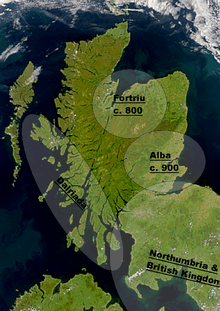Fortriu

Fortriu or the Kingdom of Fortriu is the name given by historians for an ancient Pictish kingdom (1-850 AD),[1] and often used synonymously with Pictland in general. While traditionally located in and around Strathearn in central Scotland, it is more likely to have been located in and around Moray and Easter Ross in the north.
The word itself is a modern reconstruction; it is the hypothetical Old Irish nominative form for a word that occurs only in the genitive or dative cases, as Fortrenn and Fortrinn, respectively. The reconstructed Pictish form would be *Uerturio, and indeed one of the two main Pictish tribes recorded by Roman writers is the Uerturiones.[2] The change occurred because Goidelic speakers almost always render with an f what in Brittonic languages is U/V, W or Gw; compare Scottish Gaelic Fionn with Welsh Gwyn, both meaning white.
Traditionally the kingdom has been seen as centered on central Scotland, equivalent to the Kingdom of the Southern Picts, with a heartland perhaps in Strathearn. Over the last century or so this has become a scholarly consensus.[3] However, new research by Alex Woolf seems to have destroyed this consensus, if not the idea itself. As Woolf has pointed out, the only basis for it had been that a battle had taken place in Strathearn in which the Men of Fortriu had taken part. This is an unconvincing reason on its own, because there are two Strathearns - one in the south, and one in the north - and, moreover, every battle has to be fought outside the territory of one of the combatants. By contrast, a northern recension of the Anglo-Saxon Chronicle makes it clear that Fortriu was north of the Mounth (i.e. the eastern Grampians), in the area visited by Columba.[4] The Prophecy of Berchán says that Dub, King of Scotland was killed in the Plain of Fortriu.[5] Another source, the Chronicle of the Kings of Alba, indicates that King Dub was killed at Forres, a location in Moray.[6] Moreover, additions to the Chronicle of Melrose confirm that Dub was killed by the men of Moray at Forres.[7]

The long poem known as The Prophecy of Berchán, written perhaps in the 12th century, but purporting to be a prophecy made in the Early Middle Ages, states that "Mac Bethad, the glorious king of Fortriu, will take [Scotland]."[8] As Macbeth, King of Scotland was Mormaer of Moray before he became King of Scots, there can be no doubt that Moray was how Fortriu was still understood in the High Middle Ages. Fortriu is also mentioned as one of the seven ancient Pictish kingdoms in the 13th-century source known as De Situ Albanie.
There can be little or no doubt then that Fortriu centered on northern Scotland. Other Pictish scholars, such as James E. Fraser are now taking it for granted that Fortriu was in the north of Scotland, centered on Moray and Easter Ross, where most early Pictish monuments are located.[9] Hence, it is in these areas that the united kingdom of the Picts originated, perhaps acquiring southern Pictland after the expulsion of the Northumbrians by King Bridei III of the Picts at the Battle of Dun Nechtain in 685 CE.
Relocating Fortriu north of the Mounth increases the importance of the Vikings. The Viking impact on the north was greater than in the south, and in the north, the Vikings actually conquered and made permanent territorial gains. The creation of Alba or the Kingdom of Scotland from Pictland, traditionally associated with a conquest by Kenneth MacAlpin (Old Irish Cináed mac Ailpín) in 843, can perhaps be better understood in this context.
Notes
- ↑ "Early Kingdoms of Scotland". 2013. Regnal Chronologies. Retrieved 18 May 2014.
- ↑ Watson, History of the Celtic Place-Names, pp. 68–9.
- ↑ see virtually any work dealing with the Picts before 2005.
- ↑ Woolf "Dun Nechtain, Fortriu and the Geography of the Picts."
- ↑ A. O. Anderson, Early Sources, Vol. I, p. 474.
- ↑ A. O. Anderson, Early Sources, Vol. I, p. 473.
- ↑ A. O. Anderson, Early Sources, Vol. I, pp. 473–4.
- ↑ A. O. Anderson, Early Sources, Vol. I, p. 601.
- ↑ For instance, in the Pictish Course at the University of Edinburgh.
References
- Anderson, Alan Orr, Early Sources of Scottish History: AD 500-1286, 2 Vols, (Edinburgh, 1922)
- Hudson, Benjamin T., Kings of Celtic Scotland, (Westport, 1994)
- Watson, W. J., History of the Celtic Place-Names of Scotland, (Edinburgh, 1926), reprinted, with an Introduction, full Watson bibliography and corrigenda by Simon Taylor (Edinburgh, 2004).
- Woolf, Alex, "Dun Nechtain, Fortriu and the Geography of the Picts", Scottish Historical Review 85 (2006), 182-201.
| ||||||||||||||||||||||||||||||||
